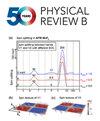Emergent topology in many-body dissipative quantum matter
IF 3.7
2区 物理与天体物理
Q1 Physics and Astronomy
引用次数: 0
Abstract
The identification, description, and classification of topological features is an engine of discovery and innovation in several fields of physics. This research encompasses a broad variety of systems, from the integer and fractional Chern insulators in condensed matter, to protected states in complex photonic lattices in optics, and the structure of the QCD vacuum. Here, we introduce another playground for topology: the dissipative dynamics of pseudo-Hermitian many-body quantum systems. For that purpose, we study two different systems, the dissipative Sachdev-Ye-Kitaev (SYK) model, and a quantum chaotic dephasing spin chain. For the two different many-body models, we find the same topological features for a wide range of parameters suggesting that they are universal. In the SYK model, we identify four universality classes, related to pseudo-Hermiticity, characterized by a rectangular block representation of the vectorized Liouvillian that is directly related to the existence of an anomalous trace of the unitary operator implementing fermionic exchange. As a consequence of this rectangularization, we identify a topological index ν that only depends on symmetry. Another distinct consequence of the rectangularization is the observation, for any coupling to the bath, of purely real topological modes in the Liouvillian. The level statistics of these real modes agree with that of the corresponding random matrix ensemble and therefore can be employed to characterize the four topological symmetry classes. In the limit of weak coupling to the bath, topological modes govern the approach to equilibrium, which may enable a direct path for experimental confirmation of topology in dissipative many-body quantum chaotic systems.求助全文
约1分钟内获得全文
求助全文
来源期刊

Physical Review B
物理-物理:凝聚态物理
CiteScore
6.70
自引率
32.40%
发文量
0
审稿时长
3.0 months
期刊介绍:
Physical Review B (PRB) is the world’s largest dedicated physics journal, publishing approximately 100 new, high-quality papers each week. The most highly cited journal in condensed matter physics, PRB provides outstanding depth and breadth of coverage, combined with unrivaled context and background for ongoing research by scientists worldwide.
PRB covers the full range of condensed matter, materials physics, and related subfields, including:
-Structure and phase transitions
-Ferroelectrics and multiferroics
-Disordered systems and alloys
-Magnetism
-Superconductivity
-Electronic structure, photonics, and metamaterials
-Semiconductors and mesoscopic systems
-Surfaces, nanoscience, and two-dimensional materials
-Topological states of matter
 求助内容:
求助内容: 应助结果提醒方式:
应助结果提醒方式:


